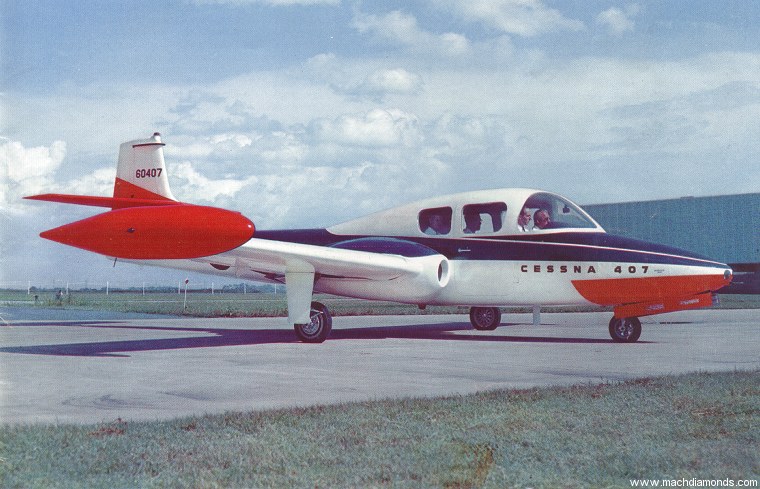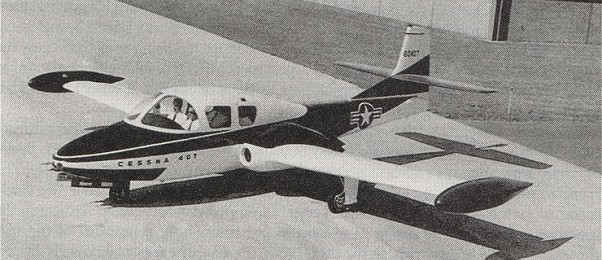Well into the producing the T-37, Cessna set aside limited engineering and marketing resources to analyze the profitability of developing a civilian version of the T-37, based on the aircraft's powerplant and airframe systems. Designated the Cessna Model 407, only a wooden fuselage mockup of the proposed aircraft was ever produced.
As Beech had encountered with the Morane Saulnier MS 760, insufficient customer interest hindered its prospects. ("The Cessna Citations", by Donald J. Porter)

Cessna Aircraft Company entered the military utility aircraft market with a four-place jet, unveiled at closed showing to military officials on September 28, 1959.
The aircraft, designated the Model 407, was a sleek, low-wing, pressurized jet. "It is designed to fulfill military needs for a multi-mission, low-cost jet," according to Dwane L. Wallace, Cessna President at the time.
"Cessna has been fully aware of the pressing military need for a low-cost jet replacement for the training and utility aircraft now being phased out of service," Wallace pointed out.
"To achieve minimum cost and maximum utility we drew upon the experience of the T-37 trainer development, and 200,000 hours of T-37 service utilization as a basis for the 407 design," he explained.
The use of T-37 tools, components and systems provides a production base for the low initial cost of the airplane, according to Cessna officials. The Model 407 utilizes standard components of the T-37 with the exception of the cockpit. The center section has been redesigned to a large pressurized cabin, which seats four persons with their baggage.
"One important achievement which has made the new aircraft possible is the development of new, higher thrust, low-cost powerplants," according to Cessna officials. The new engines provide increased speed, efficiency and range.
In commenting on the commercial potential of the 407, Wallace conceded "The Model 407 could foreseeably be the forerunner of a modern commercial fleet in the next five to ten years."
The new aircraft, with a gross weight of 9,300 pounds, has a mission range up to 1,380 nautical miles, and cruising speeds of up to 404 knots (465 mph). The jet is powered by two Continental 356-9 jet engines which produce 1,400 pounds thrust each. Maximum level flight speed of the 407 is 423 knots (487 mph).
The Continental 356-9 jet engine which powers the 407 is the newest of the proven J-69 series. This engine series has been qualified up to 1,700 pounds thrust. When especially adapted for the 407, the reduced thrust requirements have lowered turbine inlet temperatures by more than 100 degrees F, assuring long engine life.
The cabin area of the 407 is extremely large for a four-place jet. Removable rear seats afford versatility for high priority cargo transportation, or installation of sepcialized mission equipment.
The cabin is pressurized at 7.5 psi differential, or about 8,000 feet cabin altitude at the aircraft's normal cruising altitude of 35,000 ft. Service ceiling for the new jet is 46,400 ft. Single engine ceiling is in excess of 25,000 ft.
The 407, by comparison to operational jets, is small and offers low silhouette. Entrance and exit are made without ramps. Maintenance stands and special ground handling equipment are not required. Even auxiliary ground power equipment is unnecessary, for a nickel-cadmium battery fulfills power requirements for normal engine starting.
Provisions have been made for ice-free engine operation under all conditions. An especially designed ice and rain removal system has been employed for the aircraft's windshield.
Entrance and exit are made through a large door on the right side of the fuselage. An emergency window for ground exits is located on the left rear of the cabin. Baggage provisions for four persons are included within the pressurized compartment. A spacious panel display area is provided to accomodate all normal functional instrumentation at each flight station, plus complete communication and navigation installations at panel center line.
The air conditioned has a capacity of 24,500 BTU/hr at 100F OAT. The primary controls are non-bossted. The hydraulic system pressure is 1,500 PSI. The electrical system capacity is 28 Volts, 400 Amps DC and 1,250 VA, 400 Hz AC.
|
| DIMENSIONS |
|
|
| Wing Span |
37ft 10in |
11.532 m |
| Wing area |
183.9 sqft |
17.1 m2 |
| Overall length |
31 ft 8.5 in |
9.665 m |
| Fuselage length |
21 ft 6 1/2 in |
6.56 m |
| Overall height |
9ft 9.5 in |
2.985 m |
| WEIGHTS, LOADINGS |
|
|
| MTOW |
9,300 lb |
4218 kg |
| Empty weight |
4,657 lb |
2112 kg |
| Max fuel |
3,641 lb |
1652 kg |
| Baggage |
160 lb |
72.6 kg |
| Load factor |
+5.0/-2.06 |
| Wing loading |
46.4 lbs/sqft |
227 kg/m2 |
| SPEEDS |
|
|
| Normal cruise speed |
404 kts |
748 km/hr |
| Max cruise speed |
423 kts |
783 km/hr |
| Best cruise speed (FL350) |
312 kts |
578 km/h |
| Stall speed (power off, flaps down) (VSC) |
84 kts |
156 km/h |
| TAKE-OFF (ISA, SL) |
|
|
| Obstacle clearance 15m / 50ft |
2,850 ft |
869 m |
| LANDING (ISA, SL) |
|
|
| Obstacle clearance 15m / 50ft |
3,050 ft |
930 m |
| Ground roll |
1430 ft |
435 m |
| CLIMB AND ALTITUDE |
|
|
| Sea level |
3,680 ft/min |
1122 m/min |
| Engine out (SL) |
745 ft/min |
227 m/min |
| Service ceiling |
46,400 ft |
14100 m |
| One engine inop ceiling |
25,200 ft |
7681 m |
| RANGES |
|
|
| Range at 312kts (20 min res.) |
1,231 nm |
2280 km |
| Maximum range |
1,380 nm |
2550 km |
|
